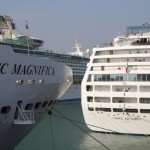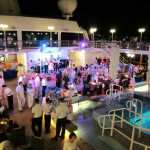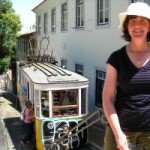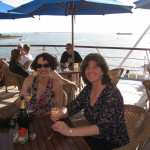Venice, Italy –
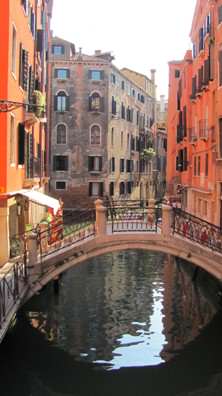
Before my voyage began I stayed for three nights at the Hotel Flora. Venice equals romantic – quaint – canals – gondoliers – carnival – palaces – glass – art – fashion – people! Venice is as wonderful today as it was 20 years ago, but it takes a little more work and a little more patience as the crowds today are significant. A pre or post cruise stay allows time to enjoy the city and such sights as an evening concert in St Mark’s Square without all the tumult present during the day. Venice is a city for pedestrians, it’s a city made for wandering – it’s hard to get lost and each turn exposes a charming balcony, a small plaza, a narrow canal.
Time permitting, a vaporetto excursion out to the island of Murano gives lovers of glass a chance to see artists at work and shop ‘til you drop in the numerous outlets showcasing jewelry, home accessories, chandeliers, and stemware.
A perfect ending to our time in Venice, a visit to Harry’s Bar and the obligatory Bellini! We took a water taxi from our hotel to the ship – speeding down the Grand Canal– could we have felt any more cosmopolitan? I doubt it. Welcome aboard! Champagne? Life is good.
Compagnie du Ponant aboard L’Austral –
We sailed from Venice to Athens along the Adriatic Coast for 7 days. The L’Austral holds an intimate 260 passengers. made up of a very international group. French and English are both used regularly onboard.
We had a balcony stateroom – very comfortable – plenty of storage space. Good closet space with enough hangers for two women traveling together! The ship was just launched in June 2011 and is elegant and tasteful. She is sailing the Mediterranean now, but L’Austral is ice-rated and will travel to Antarctica during the winter. Her small size makes it possible to visit small, less touristy ports and getting on and off the ship is a breeze. Her crew was friendly and engaging.
Piran, Slovenia
Can I start by saying that all Mediterranean cities seem to be made up of red tile roofs, charming plazas, narrow twisting streets or passageways and always a church tower that dominates the skyline. And there are church bells – the mellow sound of church bells in the background. Piran was no different. Smaller than some, simple – I thought that this must have been what the Riviera was like back in the 50s. The water was crystal clear and warm and locals and the few European tourists were swimming or sunning all along the promenade. It was just what I had hoped to find.
Trogir, Croatia
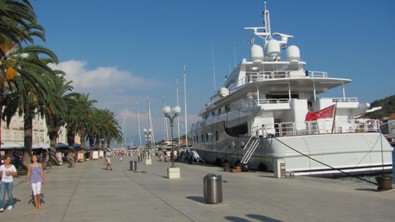
The walled, old town, situated on its own island is a UNESCO World Heritage site. Trogir has been Greek, Roman, Venetian and even French, and all of them have contributed to the cultural heritage of the city. It’s old, but very hip – rumor had it that recent visitors included the likes of Bill and Melinda and Prince Harry. We didn’t see any celebrities but certainly saw gorgeous yachts tied up along with main seawall and fantasized that they belonged to international personalities. Our event for the day was an Opera concert in the 15th century Fortress Kamerlengo. If one is going to enjoy and appreciate Opera, what better place than inside a fortress – high drama!
Dubrovnik, Croatia
One of the anticipated highlights of the trip. Our ship was able to anchor just off the entrance to the city and we tendered in – an easy transit. We plunged into the midst of the crowds and quickly found ourselves in a morning market. Vegetables, honey, lavender, wine and hand- made goods. Ignoring our common sense, we found ourselves paying the small fee to climb the staircase to begin the walk around the top of the walls during the hottest part of the day. Experience should count for something, but sometimes enthusiasm overrides it. It was hot, and there are a lot of staircases to climb to reach the tallest vantage points, but once there, we were treated to the sight of red tile roofs, winding twisting streets, steeples and the sound of church bells. At one corner of the tallest portion of the wall, a soon-to-be-millionaire offered cold, bottled water and ice cream. We enjoyed an extended day in Dubrovnik which gave us the chance to come back in the late afternoon and take the gondola to the top of the hill overlooking the port and the city. We took advantage of a nice open air restaurant at the summit to watch the sunset and have our “sun-downers” drink and gaze over the Adriatic.
Kotor, Montenegro
The setting is spectacular and getting there is compared to cruising in a Norwegian fjord. The hills are steep and come straight down to the water and the inlet goes for miles until it reaches Kotor, another walled, medieval city. We opted for a shore excursion that would take us inland to see more of this country of 650,000 inhabitants. We went up and over the steep hills to the seaside town of Budva. The beaches are gorgeous and extensive and it is this country’s hope that their Riviera will appeal to tourists as an alternative to France and Italy. We continued inland to the former Royal Capital of Cetinje. The land is covered in scrub, it’s rocky and poor. Roads are scarce – crude footpaths are more the norm. One wonders what the future will bring.
Corfu, Greece
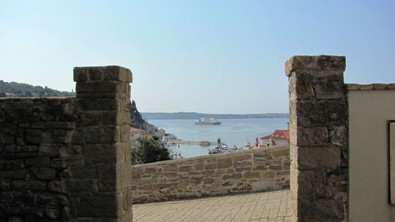
Corfu has been a European playground for years and boasts lovely beaches as well as claiming to be one of the greener regions of Greece. Before tourism, the millions of olive trees provided its income. Corfu Town is the principal port and largest town in the Ionian Islands. The town was built during the Venetian rule, between two fortresses and its architecture is influenced by all the major civilizations that once occupied the island, such as the Sicilians, the Venetians, the French and the British.
Today, the Esplanade Square is the central square of Corfu Town. We found great shopping just off the square and managed to find the perfect souvenirs for the deserving ones on our list. In retrospect, we should have shopped more in Corfu and not depended on “topping off” in Athens. We stopped for a gyro and a cold beer, barely making it back to the ship in time. We were the last to board…they were waiting for us….. je suis desole….
Itea, Greece
The lure of the Oracle is still present. Itea is the port, Delphi the destination and knowing the future is the objective. More dry, barren lands, though our road was bordered by a full aqueduct – where is the source of all that water and why isn’t it being used for irrigation? There is a wonderful museum at the ruins of Delphi – don’t pass it up – the artifacts are lovely and well displayed and enhance the appreciation of the ruins that lay just outside the door. More stone pathways, more marble steps, more pillars, columns and temples and quite possibly the stone table that the Oracle used in giving her divine vision. It is believed that naturally occurring ether and cyanide from chewing laurel leaves were used to come up with the revelations and fatal overdoses were an occupational hazard.
Corinth Canal
Leaving Itea, L’Austral headed for the Corinth Canal. This narrow passageway is only open to small ships and this would be L’Austral’s first trip through the corridor, pulled by a tug, and the Captain was understandably nervous. No marks or scratches! The crossing took about 45 minutes. Foot traffic stopped as the ship went under high bridges and we all stayed on deck and waved at those ashore. At the opposite end, the tug released her cargo, the Captain took a deep breath and resumed command and we headed off towards Athens.
Athens, Greece
We said goodbye to new found friends, grabbed a taxi and went to directly to our hotel which was across the street from Hadrian’s Gate. The gods were with us and the room was ready. Bags unloaded, cameras ready we were off to the Acropolis – just a short walk away. We were there along with the shore excursions from at least 7 cruise ships – we stayed briefly – didn’t take many pictures and fled. The following day we went to the new Acropolis Museum which made up for the day at the site. It’s built above ruins and the excavation work is incorporated into the structure of the building. The museum is fascinating, well thought out and blissfully spacious. We had been walking for two weeks so why not walk some more – we went through the Plaka, the Agora, around the ruins in front of our hotel and to the Olympic Stadium.
